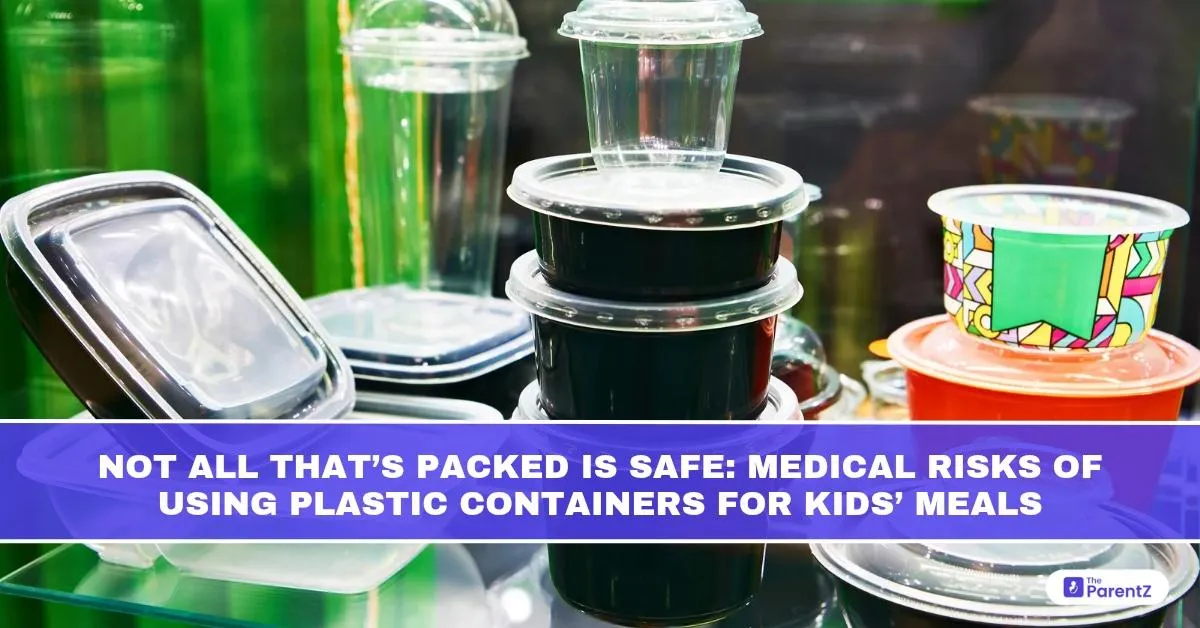“Convenience should never come at the cost of a child’s well-being.”
Whether it’s breakfast packed in a hurry or leftover dinner saved for the next day’s lunch, plastic containers have become a household staple. Lightweight, colorful, and spill-proof, they seem perfect for busy mornings and school dabbas. But behind this convenience lies a growing concern: the medical risks tied to storing and serving food in plastic, especially for children.
The Invisible Risks: How Plastic Interacts with Food
Plastics are made using a cocktail of synthetic chemicals. While most plastics are labeled “food-safe,” that term can be misleading. Under everyday conditions like heat, moisture, or acidity, these plastics may release trace amounts of harmful chemicals into food.
These chemicals don’t add taste or smell. They’re invisible, but not harmless.
Repeated exposure, even in small doses, has been associated with subtle but important health changes in children.
Immune System Disruption
Emerging research suggests certain plastic-related compounds may interfere with the immune system’s development.
How?
- Some additives used to soften or color plastic may trigger inflammatory responses.
- Long-term exposure can make children more prone to recurrent infections, allergies, or even auto-immune issues.
Key Insight: Children exposed to these chemicals may not show immediate symptoms but could face reduced resilience to infections or greater sensitivity to environmental allergens over time.
Gut Microbiome Imbalance
The gut isn’t just for digestion; it houses trillions of beneficial bacteria that regulate mood, immunity, and nutrient absorption. Studies now show that even low-level exposure to plastic residues may alter this balance.
- Chemicals like microplastics and plasticizers have been found to damage gut lining cells.
- This can lead to constipation, bloating, or poor nutrient absorption, especially in sensitive children.
- Think about it: A child may be eating home-cooked, nutritious food, but if it’s stored or reheated in the wrong container, it might still affect their gut health.
Early-Life Hormonal Sensitivity
During infancy and childhood, the body’s endocrine system is still maturing. Hormones regulate growth, metabolism, and brain development. Some plastic-related substances are now classified as endocrine-disrupting chemicals (EDCs).
They may:
- Mimic or block natural hormones like thyroid hormone, insulin, or estrogen
- Alter the timing of developmental milestones
- Affect behavior and emotional regulation
Clinical observation: Pediatric endocrinologists have seen a rising number of early puberty cases, and while multiple factors are involved, environmental exposure to synthetic hormones is one of them.
Thermal Reactions: The Heat Factor
It’s common to pour hot dal, curry, or pulao straight into a plastic lunchbox. But the combination of heat, oil, and spices accelerates chemical migration from container to food.
In fact, certain aromatic spices, like turmeric and chili, can react faster with plastic, potentially increasing the chances of chemical breakdown. Even if you’re not microwaving the plastic, just the heat from freshly cooked meals is enough to trigger leaching.
Neurological and Behavioral Effects
Recent evidence has linked early exposure to plastic-based toxins with behavioral issues such as:
- Reduced attention span
- Hyperactivity
- Poor sleep quality
This is particularly concerning for children with developing brains, where even small exposures during key periods can alter neurodevelopmental pathways.
Which Types of Plastics Pose the Greatest Risk?
Not all plastic is equally harmful, but many parents don’t know how to identify safe ones. Unfortunately, there’s no foolproof way to assess safety at home, as labels like “BPA-free” don’t guarantee full protection. Some BPA alternatives may still carry health risks.
In India, unbranded or local plastic containers sold in bulk or at lower prices often skip quality testing altogether.
What Pediatricians Are Observing
According to Dr. Neeraja Patil, a Hyderabad-based pediatric gastroenterologist:
“We’re seeing a higher frequency of digestive complaints, minor hormonal issues, and allergic reactions. While diet plays a big role, how the food is stored and served is a silent contributor that’s often overlooked.”
Better Storage Habits: What Parents Can Do
You don’t need to eliminate all plastic overnight, but some key changes can go a long way:
Choose Thermal Steel or Insulated Food Jars
- Maintain temperature
- Zero chemical leaching
- Durable and eco-friendly
Use Cloth Wrapping for Dry Foods
- Chapatis, parathas, or sandwiches can be wrapped in clean cotton cloths or banana leaves, a traditional Indian practice that’s still relevant today.
Invest in Certified Containers
- Look for ISI, FDA, or LFGB (food contact safety) markings.
- Avoid anything with peeling prints, odd smells, or flimsy lids.
Teach Children to Avoid Reheating Plastic
- If your child uses the school microwave, instruct them to transfer food to a ceramic plate before heating.
Final Words: Prevention is Simpler than Cure
While food packaging might seem like a small detail in the bigger picture of parenting, its impact can be surprisingly significant. By being mindful of storage materials, we’re not just preserving the quality of meals; we’re protecting growing bodies from avoidable chemical exposure. Because at the end of the day, a nourishing lunch box is about more than food; it’s about safety, trust, and long-term health.








Be the first one to comment on this story.